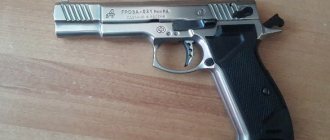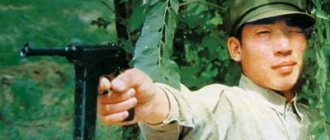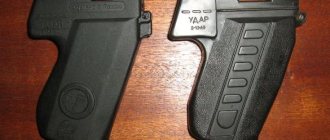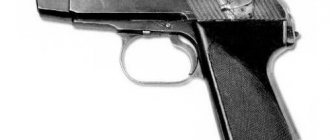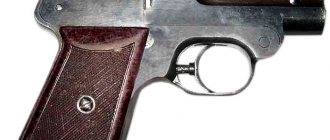The history of the revolver
The first revolvers of the 16th century were very unreliable and even dangerous weapons. To ignite gunpowder, it was necessary to set it on fire using silicon or a wick. Theoretically, burning gunpowder on a special shelf activated the charge in the revolver cylinder. In fact, not only the desired charge often ignited, but also neighboring ones. This often resulted in injury to the shooter or rupture of the weapon's barrel.
Eventually, in 1818, Artemas Wheeler designed a flintlock revolver. However, the North American patent obtained for this invention was not significant, unlike the British document. Instead, having gone to Britain and slightly improved the revolver, his comrade Collier received a patent.
But the real birthday of the revolver is considered to be February 25, 1836, when the unknown gunsmith designer Samuel Colt invented the capsule weapon. Using the previously created capsule mechanism, Colt patented a new Colt Paterson revolver, equipped with a 6-cartridge drum.
Invisible pistol "Glass Gan"
There is only one way - the use of new high-strength plastics and metal-ceramics for the most loaded parts. The creators of the “Glass Gan” invisible pistol, which is in service with the American intelligence services, followed this path. The weapon reloads automatically: the principle of automation is the recoil of the free shutter. The shot occurs from the rear sear, that is, as in submachine guns. This design is quite simple and reliable.
The weapon is designed for caseless cartridges, which are also not detected by metal detectors. The ceramic bullet has a plastic coating, which interacts with the rifling in the barrel. The sharp edges of the rifling create additional stresses in the structure, to which cermets are much more sensitive than ordinary steel, so the rifling of the barrel is made polygonal.
For greater secrecy, the pistol is equipped with a conventional integrated silencer. Magazine capacity 15 rounds. As you can see, it’s a completely modern weapon.
Description[ | ]
The revolver has a self-cocking trigger mechanism with an open trigger. To remove spent cartridges, the drum tilts to the left, and when you press the extractor located on the central axis of the drum, all spent cartridges are removed at once. The drum lock button is located above the handle, behind the drum. The trigger guard has a protrusion for the finger of the second hand when shooting with two hands. There is a safety in the handle of the revolver that turns off when you put your hand on the handle. The sight is open, non-adjustable. The cheeks of the handle are made of black plastic[3].
A laser target designator can be installed on the revolver.
"Blow" of large caliber
In the early 90s, by order of the Ministry of Internal Affairs of the Russian Federation, designers tried to combine combat and non-lethal capabilities on the basis of a revolver. New revolver systems adopted by law enforcement agencies had limited use, and their service and civilian versions also did not become widespread.
Klimovsky "Udar"
Back in 1990, the Research Institute of Special Equipment (NIIST) of the USSR Ministry of Internal Affairs, together with the Klimov Central Scientific Research Institute of Precision Engineering (TsNIITOMASH), as part of the experimental design work (R&D) “Udar”, began designing a new weapon for employees of internal affairs bodies. The main feature of “Udar” was planned to be a combination of lethal and non-lethal properties of weapons. For this purpose, the revolver's arsenal included several ammunition options.
In order to combine two different purposes of the weapon, the experts settled on a 12.3 mm caliber, large for military small arms, which was a 32-caliber quite common for hunting weapons. The target element was placed in a hunting cartridge shortened to 50 mm with a pistol igniter primer and a charge of pyroxylin powder. The main large-caliber ammunition of the "Udar" was the SP9B combat cartridge with a bullet with a steel core, similar in design to the SP10, and a non-lethal cartridge with a bullet filled with shot in a plastic shell. After modification, the non-lethal SP9N cartridge began to be equipped with three plastic balls. This solution, with a relatively low accuracy of fire at a distance of 15 m, made it possible to significantly increase the affected area. The final ammunition load of the police “Udar” was supplemented with pyro-liquid and flash-noise (blank) cartridges.
In 1993, the large-caliber Udar revolver was first demonstrated to specialists at the Milipol exhibition, and in December 1994 it entered trial operation by some units of the Ministry of Internal Affairs of the Russian Federation. The weapon, like the cartridges, was developed by TsNIITOCHMASH specialists. The RG053 revolver had a classic layout with the ability to fire by self-cocking, standard dimensions and a relatively large weight - about 1 kg. The main difference of the Klimov “Udar” was the quick-release drum for the convenience of loading with cartridges or replacing with a new one, already equipped in advance. The weight of the drum with live ammunition was 380 g. Extraction of spent cartridges is carried out using a special sprocket by pressing on the protruding sleeve of the removed drum.
Despite the fact that the “Udar” was significantly superior to the standard PM both in accuracy of fire and in its lethal and stopping effect, the new weapon did not gain popularity among law enforcement officers. The complete set of the revolver, which included an operational (or belt) holster with two spare drums in cases, reached an impressive weight of 1.6 kg. SP9 cartridges and the RG053 revolver entered service with law enforcement agencies in 1998, and their mass production was carried out at TsNIITOCHMASH.
all4shooters.com / all4hunters.com - international website for sports shooters and hunters
BE A SHOOTER!
Guns, ammo, optics and passion: these are the four key elements that unite gun enthusiasts around the world. all4shooters.com is an international platform that will be your window to this world - in four languages.
The motto of all4shooters.com and all4hunters.com is simple:
We exist for all those who have a passion for hunting and shooting, both as a shooting sport and as a hobby - or for those who are simply lovers of weapons, optics and accessories. At all4hunters.com we focus on hunting weapons, hunting ammunition and related optics and equipment. We also provide the latest news from around the world, as well as everything you need to know about new products and events related to your specific hobby. We provide important information about each relevant market - in four different languages. Our deep understanding of each individual market is where our strength lies—along with our ability to deliver information worldwide via the Internet.
Notes
- ↑ 12345
Victor Ron. TsKIB revolvers // “Weapons” magazine, No. 3, 2010, pp. 18-19 - L. E. Sytin.
All about firearms. - "Polygon", 2012. - P. 443. - 646 p. — ISBN 978-5-89173-565-1. - Borzov Boris Afanasyevich (03/09/1944 - 04/21/2002)
- ↑ 12
A. Naydenov, N. Kislitsyna. Original MTs-255 // magazine “Hunting and Hunting Management”, No. 4, 2007. pp. 30-31 - Revolver “Gnome” // A. I. Blagovestov. What they shoot from in the CIS / ed. A.E. Taras. Minsk, “Harvest”, M., LLC “AST Publishing House”, 2000. p.41
Cartridges for modern weapons
Today, revolvers are loaded with unitary cartridges with a metal sleeve. The first such element was designed by N. Dreyse back in 1827, long before the appearance of the revolver. At that time, such a cartridge was used in long-barreled weapons.
Over time, the idea was picked up by the creators of revolvers. Such a charge consisted of a metal sleeve, a primer and a bullet.
Currently, models of modern revolvers are weapons with a double action trigger mechanism. The drum of such revolvers tilts to the left side, and when a special extractor is pressed, all the cartridges are pulled out of it. Many revolvers are chambered in powerful .357 Magnum and .44 Magnum calibers. Cartridges for such weapons consist of a cartridge case with a special rim (rim) that holds the cartridge in the drum. Cartridges without this element are also possible. In this case, holders are used to hold them - plates in the shape of two crescents.
Explanation of symbols
For example, 1Gnome 6-10D 220V
- 1 — modification with a plastic case;
- Gnome - model name;
- 6 (m3/h) – nominal flow rate;
- 10 (m) – nominal pressure;
- D – float level sensor;
- in this example there is no designation of the temperature regime - therefore, cold water heated to 35ºC can be pumped; for hot water you should buy a Gnome pump marked “Tr”)
- 220V - mains voltage.
all4shooters.com / all4hunters.com - international website for sports shooters and hunters
BE A SHOOTER!
Guns, ammo, optics and passion: these are the four key elements that unite gun enthusiasts around the world. all4shooters.com is an international platform that will be your window to this world - in four languages.
The motto of all4shooters.com and all4hunters.com is simple:
We exist for all those who have a passion for hunting and shooting, both as a shooting sport and as a hobby - or for those who are simply lovers of weapons, optics and accessories. At all4hunters.com we focus on hunting weapons, hunting ammunition and related optics and equipment. We also provide the latest news from around the world, as well as everything you need to know about new products and events related to your specific hobby. We provide important information about each relevant market - in four different languages. Our deep understanding of each individual market is where our strength lies—along with our ability to deliver information worldwide via the Internet.
Advantages
- The ability of the pumping part to pump liquids along with mechanical contaminants.
- Calculating the strength of the housing parts helps prevent deformation when handling the pump.
- The structural reliability of the units has been increased through the use of mechanical seals.
- There is no need to monitor operating parameters during the life of the electric pump.
- Minimal harmful effects on people: vibration and noise factors are absent, which is due to the submersible nature of the pump installation at depth.
- Possibility of purchasing a Gnome pump of appropriate size and performance at a price below the market average.
Description[ | ]
The revolver has a self-cocking trigger mechanism with an open trigger. To remove spent cartridges, the drum tilts to the left, and when you press the extractor located on the central axis of the drum, all spent cartridges are removed at once. The drum lock button is located above the handle, behind the drum. The trigger guard has a protrusion for the finger of the second hand when shooting with two hands. There is a safety in the handle of the revolver that turns off when you put your hand on the handle. The sight is open, non-adjustable. The cheeks of the handle are made of black plastic[3].
A laser target designator can be installed on the revolver.
Where are they used?
The scope of application of GNOM series products is quite wide:
- pump clean water and contaminated water mixtures into the environment for the needs of homes, public utilities and other industries (construction, agriculture);
- GNOM installations are capable of removing hot wastewater in case of emergency situations at the facility;
- GNOM pumps are used to equip drainage systems and water intakes;
- this equipment is especially effective when pumping wastewater containing oil contaminants;
- you can buy a Gnome submersible pump for home use (from irrigation and water supply functions to cleaning sewer systems).
Modern weapons of Europe
The first official patent for drum pistols was received in Britain. And today, European manufacturers surprise consumers with their original approaches to creating firearms.
This also applies to the French modern Manurhin MR 73 revolvers of .357 Magnum caliber. The first weapon was created at the Manurin factory and was similar to the Walter pistol. At the same time, the firearm somewhat repeated the system of the Smith & Wesson revolver. The difference was the double-action trigger mechanism, which had a locking trigger pull. The Manurin drum holds 6 rounds.
Belgian brothers Henri-Leon and Emile Nagant created revolvers that became popular all over the world. At first they repaired the Dutch Hemburg guns, but soon decided to produce their own firearms. And although the first Nagan appeared back in 1878, it remains the leader among revolvers today.
R - 92
Caliber, mm 9 Length, mm 157 Height, mm 120 Width, mm 35 Weight without cartridges, 520 g Drum capacity 5 Year of manufacture 1992 The P 92 revolver is designed to defeat enemy personnel at short distances. Developed at the Tula Instrument Design Bureau in 1992 as a service weapon for various types of security and private security services. Double action trigger mechanism. The trigger is semi-hidden, allowing the P 92 to be quickly grabbed and placed in a pocket or holster as the trigger does not stick to clothing or objects. When firing, the penetration of powder gases into the space between the barrel and the drum is prevented by pressing the drum onto the barrel when firing. Due to the fact that the 9x18 PM cartridges used do not have side flanges, they are combined into clips of five, which also speeds up reloading the revolver. Removing used cartridges - simultaneous; When removed, the drum is tilted toward the left side of the weapon. Due to the translational movement of the handle with the trigger mechanism located inside it, the revolver turned out to be relatively compact and lightweight. The convenience of aiming and shooting from it also affected, due to the fact that the center of gravity of the revolver is shifted to the center. The sights are not adjustable, the handle covers are made of plastic, and have side and rear recesses. Sources
- https://VKadety.ru/strelkovoe/revolver-gnom.html
- https://sport-nutrition-rus.ru/revolvery/revolver-ots-20-gnom-obzor-foto-harakteristiki.html
- https://8war.ru/artilleriya/oc-20-gnom.html
- https://kombat-poligon.ru/drugoe/oc-20.html
- https://fishki.net/2414173-takie-raznye-revolyvery-2.html
- https://arena-pilotage.ru/oruzhie/oc-22-gnom.html
An excerpt characterizing the OTs-20 “Gnome”
“Well, Colonel,” he shouted while still driving, “I told you to light the bridge, but now someone has misinterpreted it; Everyone there is going crazy, you can’t understand anything. The colonel slowly stopped the regiment and turned to Nesvitsky: “You told me about flammable substances,” he said, “but you didn’t tell me anything about lighting things.” “Why, father,” Nesvitsky said, stopping, taking off his cap and straightening his sweat-wet hair with his plump hand, “how come you didn’t say to light the bridge when the flammable substances were put in?” “I’m not your “father,” Mr. Staff Officer, and you didn’t tell me to light the bridge! I know the service, and it’s my habit to strictly carry out orders. You said the bridge will be lit, but who will light it, I cannot know with the Holy Spirit... “Well, it’s always like this,” Nesvitsky said, waving his hand. - How are you here? – he turned to Zherkov. - Yes, for the same thing. However, you are damp, let me squeeze you out. “You said, Mr. Staff Officer,” the colonel continued in an offended tone... “Colonel,” interrupted the retinue officer, “we must hurry, otherwise the enemy will move the guns to a grape shot.” The colonel silently looked at the retinue officer, at the fat staff officer, at Zherkov and frowned. “I’ll light the bridge,” he said in a solemn tone, as if expressing that, despite all the troubles being caused to him, he would still do what he had to do. Hitting the horse with his long muscular legs, as if it were all to blame, the colonel moved forward to the 2nd squadron, the same one in which Rostov served under the command of Denisov, and ordered to return back to the bridge. “Well, that’s right,” thought Rostov, “he wants to test me!” “His heart sank and the blood rushed to his face. “Let him see if I’m a coward,” he thought. Again, on all the cheerful faces of the squadron people, that serious feature appeared that was on them while they were standing under the cannonballs. Rostov, without taking his eyes off, looked at his enemy, the regimental commander, wanting to find confirmation of his guesses on his face; but the colonel never looked at Rostov, but looked, as always at the front, strictly and solemnly. A command was heard. - Alive! Alive! – several voices spoke around him. Clinging to the reins with their sabers, rattling their spurs and hurrying, the hussars dismounted, not knowing what they would do. The hussars were baptized. Rostov no longer looked at the regimental commander - he had no time. He was afraid, with a sinking heart he was afraid that he might fall behind the hussars. His hand trembled as he handed the horse to the handler, and he felt the blood rushing to his heart. Denisov, falling back and shouting something, drove past him. Rostov saw nothing except the hussars running around him, clinging to their spurs and clanking their sabers.


